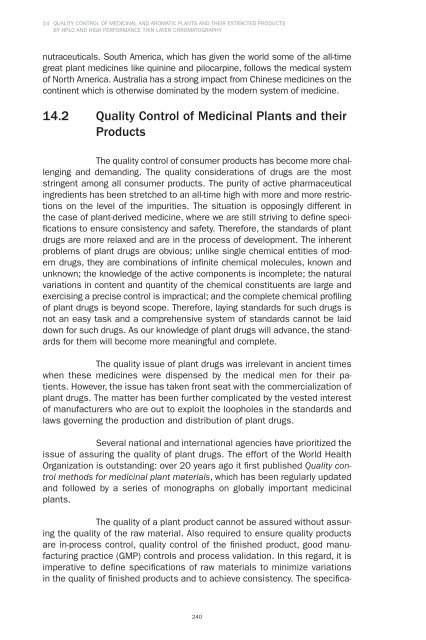Extraction Technologies For Medicinal And Aromatic Plants - Unido
Extraction Technologies For Medicinal And Aromatic Plants - Unido
Extraction Technologies For Medicinal And Aromatic Plants - Unido
You also want an ePaper? Increase the reach of your titles
YUMPU automatically turns print PDFs into web optimized ePapers that Google loves.
14 QUALITY CONTROL OF MEDICINAL AND AROMATIC PLANTS AND THEIR EXTRACTED PRODUCTS<br />
BY HPLC AND HIGH PERFORMANCE THIN LAYER CHROMATOGRAPHY<br />
nutraceuticals. South America, which has given the world some of the all-time<br />
great plant medicines like quinine and pilocarpine, follows the medical system<br />
of North America. Australia has a strong impact from Chinese medicines on the<br />
continent which is otherwise dominated by the modern system of medicine.<br />
14.2 Quality Control of <strong>Medicinal</strong> <strong>Plants</strong> and their<br />
Products<br />
The quality control of consumer products has become more challenging<br />
and demanding. The quality considerations of drugs are the most<br />
stringent among all consumer products. The purity of active pharmaceutical<br />
ingredients has been stretched to an all-time high with more and more restrictions<br />
on the level of the impurities. The situation is opposingly different in<br />
the case of plant-derived medicine, where we are still striving to defi ne specifi<br />
cations to ensure consistency and safety. Therefore, the standards of plant<br />
drugs are more relaxed and are in the process of development. The inherent<br />
problems of plant drugs are obvious; unlike single chemical entities of modern<br />
drugs, they are combinations of infi nite chemical molecules, known and<br />
unknown; the knowledge of the active components is incomplete; the natural<br />
variations in content and quantity of the chemical constituents are large and<br />
exercising a precise control is impractical; and the complete chemical profi ling<br />
of plant drugs is beyond scope. Therefore, laying standards for such drugs is<br />
not an easy task and a comprehensive system of standards cannot be laid<br />
down for such drugs. As our knowledge of plant drugs will advance, the standards<br />
for them will become more meaningful and complete.<br />
The quality issue of plant drugs was irrelevant in ancient times<br />
when these medicines were dispensed by the medical men for their patients.<br />
However, the issue has taken front seat with the commercialization of<br />
plant drugs. The matter has been further complicated by the vested interest<br />
of manufacturers who are out to exploit the loopholes in the standards and<br />
laws governing the production and distribution of plant drugs.<br />
Several national and international agencies have prioritized the<br />
issue of assuring the quality of plant drugs. The effort of the World Health<br />
Organization is outstanding: over 20 years ago it fi rst published Quality control<br />
methods for medicinal plant materials, which has been regularly updated<br />
and followed by a series of monographs on globally important medicinal<br />
plants.<br />
The quality of a plant product cannot be assured without assuring<br />
the quality of the raw material. Also required to ensure quality products<br />
are in-process control, quality control of the fi nished product, good manufacturing<br />
practice (GMP) controls and process validation. In this regard, it is<br />
imperative to defi ne specifi cations of raw materials to minimize variations<br />
in the quality of fi nished products and to achieve consistency. The specifi ca-<br />
240

















